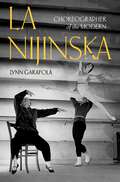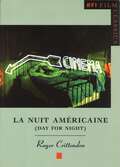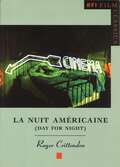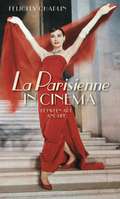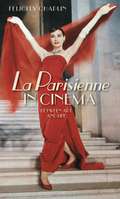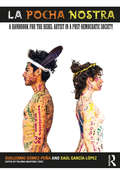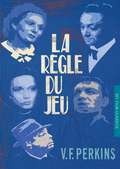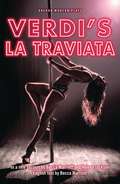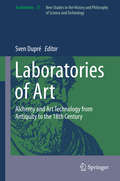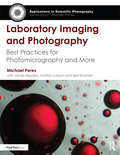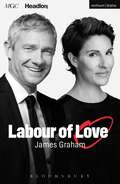- Table View
- List View
La Nijinska: Choreographer of the Modern
by Lynn GarafolaLa Nijinska is the first biography of twentieth-century ballet's premier female choreographer. Overshadowed in life and legend by her brother Vaslav Nijinsky, Bronislava Nijinska had a far longer and more productive career. An architect of twentieth-century neoclassicism, she experienced the transformative power of the Russian Revolution and created her greatest work - Les Noces - under the influence of its avant-garde. Many of her ballets rested on the probing of gender boundaries, a mistrust of conventional gender roles, and the heightening of the ballerina's technical and artistic prowess. A prominent member of Russia Abroad, she worked with leading figures of twentieth-century art, music, and ballet, including Stravinsky, Diaghilev, Poulenc, Alexandra Exter, Natalia Goncharova, Frederick Ashton, Alicia Markova, and Maria Tallchief. She was also a remarkable dancer in her own right with a bravura technique and powerful stage presence that enabled her to perform an unusually broad repertory. Finally, she was the author of an acclaimed volume of memoirs in addition to a major treatise on movement. Nijinska's career sheds new light on the modern history of ballet and of modernism more generally, recuperating the memory of lost works and forgotten artists, many of them women. But it also reveals the sexism pervasive in the upper echelons of the early and mid-twentieth-century ballet world, barriers that women choreographers still confront.
La Nijinska: Choreographer of the Modern
by Lynn GarafolaLa Nijinska is the first biography of twentieth-century ballet's premier female choreographer. Overshadowed in life and legend by her brother Vaslav Nijinsky, Bronislava Nijinska had a far longer and more productive career. An architect of twentieth-century neoclassicism, she experienced the transformative power of the Russian Revolution and created her greatest work - Les Noces - under the influence of its avant-garde. Many of her ballets rested on the probing of gender boundaries, a mistrust of conventional gender roles, and the heightening of the ballerina's technical and artistic prowess. A prominent member of Russia Abroad, she worked with leading figures of twentieth-century art, music, and ballet, including Stravinsky, Diaghilev, Poulenc, Alexandra Exter, Natalia Goncharova, Frederick Ashton, Alicia Markova, and Maria Tallchief. She was also a remarkable dancer in her own right with a bravura technique and powerful stage presence that enabled her to perform an unusually broad repertory. Finally, she was the author of an acclaimed volume of memoirs in addition to a major treatise on movement. Nijinska's career sheds new light on the modern history of ballet and of modernism more generally, recuperating the memory of lost works and forgotten artists, many of them women. But it also reveals the sexism pervasive in the upper echelons of the early and mid-twentieth-century ballet world, barriers that women choreographers still confront.
La Nuit Américaine (BFI Film Classics)
by Roger CrittendenThis intimate book draws extensively on research in the archives of Francois Truffaut's company, Les Films du Carrosse, and on interviews with many of La Nuit américaine cast and crew. They bear witness to Truffaut's passion for film.La Nuit américaine (Day for Night) is Truffaut's hymn of joy to the cinema, which charts the pleasures and pains enjoyed or endured by the cast and crew of a film as it is being shot in the Victorine Studios in Nice. It won the Oscar for Best Foreign Film in 1973.
La Nuit Américaine (BFI Film Classics)
by Roger CrittendenThis intimate book draws extensively on research in the archives of Francois Truffaut's company, Les Films du Carrosse, and on interviews with many of La Nuit américaine cast and crew. They bear witness to Truffaut's passion for film.La Nuit américaine (Day for Night) is Truffaut's hymn of joy to the cinema, which charts the pleasures and pains enjoyed or endured by the cast and crew of a film as it is being shot in the Victorine Studios in Nice. It won the Oscar for Best Foreign Film in 1973.
La Parisienne in cinema: Between art and life
by Felicity ChaplinChic, sophisticated, seductive, and enigmatic, the Parisienne possesses a je ne sais quoi which makes her difficult to define. Who or what is the Parisienne and how she is depicted in cinema is the subject of this new and exciting book. In the first book-length publication to explore la Parisienne in cinema, Chaplin expands on existing scholarship on the Parisienne type in fields such as art history, literature, and fashion history, and builds on scholarship on the films discussed to both enrich and offer new perspectives on these films. Accessible and wide-ranging, this interdisciplinary and lively work will be of immediate interest to students and researchers working in Film Studies and French Studies and the broader humanities as well as a general interest audience. It is also essential reading for cinephiles and Francophiles alike.
La Parisienne in cinema: Between art and life
by Felicity ChaplinChic, sophisticated, seductive, and enigmatic, the Parisienne possesses a je ne sais quoi which makes her difficult to define. Who or what is the Parisienne and how she is depicted in cinema is the subject of this new and exciting book. In the first book-length publication to explore la Parisienne in cinema, Chaplin expands on existing scholarship on the Parisienne type in fields such as art history, literature, and fashion history, and builds on scholarship on the films discussed to both enrich and offer new perspectives on these films.Accessible and wide-ranging, this interdisciplinary and lively work will be of immediate interest to students and researchers working in Film Studies and French Studies and the broader humanities as well as a general interest audience. It is also essential reading for cinephiles and Francophiles alike.
La Pocha Nostra: A Handbook for the Rebel Artist in a Post-Democratic Society
by Guillermo Gómez-Peña Saúl García-LópezLa Pocha Nostra: A Handbook for the Rebel Artist in a Post-Democratic Society marks a transformation from its sister book, Exercises for Rebel Artists, into a pedagogical matrix suited for use as a performance handbook and conceptual tool for artists, activists, theorists, pedagogues, and trans-disciplinary border crossers of all stripes. Featuring a newly reworked outline of La Pocha Nostra's overall pedagogy, and how it has evolved in the time of Trump, cartel violence, and the politics of social media, this new handbook presents deeper explanations of the interdisciplinary pedagogical practices developed by the group that has been labeled "the most influential Latino/a performance troupe of the past ten years." Co-written by Guillermo Gómez-Peña in collaboration with La Pocha Nostra’s artistic co-director Saúl García-López and edited by Paloma Martinez-Cruz, this highly anticipated follow-up volume raises crucial questions in the new neo-nationalist era. Drawing on field experience from ten years of touring, the authors blend original methods with updated and revised exercises, providing new material for teachers, universities, radical artists, curators, producers, and students. This book features: Introductions by the authors and editor to Pocha Nostra practice in a post-democratic society. Theoretical, historical, poetic, and pedagogical contexts for the methodology. Suggestions for how to use the book in the classroom and many other scenarios. Detailed, hands-on exercises for using Pocha Nostra-inspired methods in workshops. A step-by-step guide to creating large-scale group performances. New, unpublished photos of the Pocha Nostra methods in practice. Additional texts by Reverend Billy and Savitri D., Dragonfly, Francesca Carol Rolla, VestAndPage, Micha Espinosa, Zulfikar Ali Bhutto, Praba Pilar, L. M. Bogad, Anuradha Vikram, and Annie Sprinkle and Beth Stephens, among many others. The book is complemented by the new book Gómez-Peña Unplugged: Texts on Live Art, Social Practice and Imaginary Activism (2008–2019).
La Pocha Nostra: A Handbook for the Rebel Artist in a Post-Democratic Society
by Guillermo Gómez-Peña Saúl García-LópezLa Pocha Nostra: A Handbook for the Rebel Artist in a Post-Democratic Society marks a transformation from its sister book, Exercises for Rebel Artists, into a pedagogical matrix suited for use as a performance handbook and conceptual tool for artists, activists, theorists, pedagogues, and trans-disciplinary border crossers of all stripes. Featuring a newly reworked outline of La Pocha Nostra's overall pedagogy, and how it has evolved in the time of Trump, cartel violence, and the politics of social media, this new handbook presents deeper explanations of the interdisciplinary pedagogical practices developed by the group that has been labeled "the most influential Latino/a performance troupe of the past ten years." Co-written by Guillermo Gómez-Peña in collaboration with La Pocha Nostra’s artistic co-director Saúl García-López and edited by Paloma Martinez-Cruz, this highly anticipated follow-up volume raises crucial questions in the new neo-nationalist era. Drawing on field experience from ten years of touring, the authors blend original methods with updated and revised exercises, providing new material for teachers, universities, radical artists, curators, producers, and students. This book features: Introductions by the authors and editor to Pocha Nostra practice in a post-democratic society. Theoretical, historical, poetic, and pedagogical contexts for the methodology. Suggestions for how to use the book in the classroom and many other scenarios. Detailed, hands-on exercises for using Pocha Nostra-inspired methods in workshops. A step-by-step guide to creating large-scale group performances. New, unpublished photos of the Pocha Nostra methods in practice. Additional texts by Reverend Billy and Savitri D., Dragonfly, Francesca Carol Rolla, VestAndPage, Micha Espinosa, Zulfikar Ali Bhutto, Praba Pilar, L. M. Bogad, Anuradha Vikram, and Annie Sprinkle and Beth Stephens, among many others. The book is complemented by the new book Gómez-Peña Unplugged: Texts on Live Art, Social Practice and Imaginary Activism (2008–2019).
La Regle du jeu (BFI Film Classics)
by V.F. PerkinsRenoir's famous and controversial comedy of manners has a troubled history. Victor Perkins presents here a sensitive socio-historical study of Renoir's revised edition of the film, released 20 years after its premiere; shaped by the profundity and originality of its form.
La Regle du jeu (BFI Film Classics)
by V.F. PerkinsRenoir's famous and controversial comedy of manners has a troubled history. Victor Perkins presents here a sensitive socio-historical study of Renoir's revised edition of the film, released 20 years after its premiere; shaped by the profundity and originality of its form.
La Règle du Jeu: French Film Guide (Ciné-File French Film Guides)
by Keith ReaderOf Jean Renoir's 'La Règle du jeu' (1939), Richard Roud noted: 'if France were destroyed tomorrow and nothing remained but this film, the whole country and its civilisation could be reconstructed from it.' An extravagant claim, but one that in the view of Keith Reader is justified. In this original, up-to-date, scrupulously documented book on one of the great films of world cinema, Reader focuses on 'La Règle du jeu' in the context of both the time in which it was made and the currents of intertextuality by which it is traversed. He examines sequences from the film itself, its themes, reception and critical approaches and readings. He also explores its extraordinary subversive charge and its dynamic effect on subsequent generations of filmmakers, including Alain Resnais and Robert Altman. This is the essential companion to 'La Règle du jeu', demonstrating as it does why this film remains so central to French cinema and to the history of French and indeed European culture.
La Traviata (Oberon Modern Plays)
by Becca Marriott Helena JacksonThe acclaimed company behind the Olivier Award-nominated (‘Best New Opera, 2018’) production of La bohème present a radical reimagining of Verdi’s incendiary tale of sex, class and power, La Traviata. England, 2018.Violetta earns her crust dancing for the rich and powerful at an exclusive gentleman’s club until a chance meeting with naive and idealistic Elijah changes everything. The powerful collide with the powerless, with earth-shattering consequences for all involved. Combining Verdi’s breathtaking music with a new English version from Becca Marriott and Helena Jackson, this is La Traviata exposed, uncovered and redefined for the twenty-first century.
The Lab: Creativity and Culture
by David EdwardsNever has the spirit of innovation been more highly valued than today. Around the world, people see the hard-to-teach skills of creativity as the lifeblood of cultural change and the engine of economic development. In The Lab, David Edwards presents a blueprint for revitalizing labs with "artscience"? creative thought that erases conventional boundaries between art and science?to produce innovations that otherwise might never see the light of day. At the heart of The Lab is "cultural incubation," whereby ideas translate with free-wheeling public exchange through a kind of innovation funnel—from educational settings (as in The Lab at Harvard University), to cultural settings (as at Le Laboratoire in Paris and elsewhere), to realizations as innovative products or humanitarian initiatives (within LaboGroup and other translation labs around the globe). With examples ranging from breathable chocolate (Le Whif) to contemporary art installations that explore the neuroscience of fear, Edwards shows how a measured-risk, seed-investment, mentorship-focused network of labs can allow exotic, unexpected ideas to flourish without being killed off at the first hint of impracticality. Unique to the innovation funnel is how creator risk is encouraged but also managed by mentors and others in each lab, so that the most daring ideas—lighting African villages with microbiotic lamps, or cleaning the air with plant-based filters—can emerge within passionate and sometimes inexperienced creative bands. Lively and engaging, replete with anecdotes that bring Edwards's unique personal experience in developing artscience labs to life, The Lab approaches innovation from exciting new angles, finding invigorating ways to repurpose our most creative assets—in scientific exploration, artistic imagination, and business model-building. David Edwards teaches at Harvard University in the School of Engineering and Applied Sciences. His creative work is described at www.davidideas.com.
Laban's Efforts in Action: A Movement Handbook for Actors with Online Video Resources
by Vanessa Ewan Kate SagovskyAs an actor, awareness of your movement is the key to transformation. By making deliberate physical choices, you can fully and articulately embody different ways of being: you can come someone or something else. Laban's Efforts give you a way of identifying and making these choices. Working with them helps the actor to create wholly present and physically ambitious performances. This book outlines Ewan's practical process, which allows the actor to understand their own movement and that of others by exploring one key part of Laban's work: the 'Efforts of Action Drive'. This complete, stage-by-stage, working process has been developed through more than thirty years of work with actors in the studio. Clear instructions for practical exercises are woven throughout the book, as well as exciting ways to apply the work in rehearsal, performance and on set. This allows the actor to learn and apply Laban's Efforts for themselves. Full video and audio resources allow the reader to experience the practical work in action."Vanessa Ewan's work with Laban and the Efforts, as you will find in this inspired book, provides performers with an incredibly fertile foundation from which to create. She has found an astoundingly practical way of applying Laban's work to the quest of being a fully embodied actor. You will find tools in this book that will open door after door to your own creativity and awaken you to the endless possibility of what you can create on stage and on screen." Andrew Garfield, actor
Laban's Efforts in Action: A Movement Handbook for Actors with Online Video Resources
by Vanessa Ewan Kate SagovskyAs an actor, awareness of your movement is the key to transformation. By making deliberate physical choices, you can fully and articulately embody different ways of being: you can come someone or something else. Laban's Efforts give you a way of identifying and making these choices. Working with them helps the actor to create wholly present and physically ambitious performances. This book outlines Ewan's practical process, which allows the actor to understand their own movement and that of others by exploring one key part of Laban's work: the 'Efforts of Action Drive'. This complete, stage-by-stage, working process has been developed through more than thirty years of work with actors in the studio. Clear instructions for practical exercises are woven throughout the book, as well as exciting ways to apply the work in rehearsal, performance and on set. This allows the actor to learn and apply Laban's Efforts for themselves. Full video and audio resources allow the reader to experience the practical work in action."Vanessa Ewan's work with Laban and the Efforts, as you will find in this inspired book, provides performers with an incredibly fertile foundation from which to create. She has found an astoundingly practical way of applying Laban's work to the quest of being a fully embodied actor. You will find tools in this book that will open door after door to your own creativity and awaken you to the endless possibility of what you can create on stage and on screen." Andrew Garfield, actor
Labor and Aesthetics in European Contemporary Dance: Dancing Precarity
by Annelies Van AsscheThis transdisciplinary study scientifically reports the way the established contemporary dance sector in Europe operates from a micro-perspective. It provides a dance scholarly and sociological interpretation of its mechanisms by coupling qualitative data (interview material, observations, logbooks, and dance performances) to theoretical insights. The book uncovers the sometimes contradicting mechanisms related to the precarious project-oriented labor and art market that determine the working and living conditions of contemporary dance artists in Europe’s dance capitals Brussels and Berlin. In addition, it examines how these working and living conditions affect the work process and outcome. From a sociological perspective, the book engages with the relevant contemporary social issue of precarity and this within the much-at-risk professional group of contemporary dance artists. In this regard, the research brings novelty within the subject area, particularly by employing a unique methodological approach. Although the research is initially set up in a specific geographical context and within a specific research population, the book offers insights into issues that affect our neoliberal society at large. The research findings show potential to make a relevant contribution with regards to precarity within dance studies and performance studies, but also labor studies and cultural sociology.
Labor and Creativity in New York’s Global Fashion Industry (Routledge Research in Design Studies)
by Christina H. MoonThis book tells the story of fashion workers engaged in the labor of design and the material making of New York fashion. Christina H. Moon offers an illuminating ethnography into the various sites and practices that make up fashion labor in sample rooms, design studios, runways, factories, and design schools of the New York fashion world. By exploring the work practices, social worlds, and aspirations of fashion workers, this book offers a unique look into the meaning of labor and creativity in 21st century global fashion. This book will be of interest to scholars in design studies, fashion history, and fashion labor.
Labor and Creativity in New York’s Global Fashion Industry (Routledge Research in Design Studies)
by Christina H. MoonThis book tells the story of fashion workers engaged in the labor of design and the material making of New York fashion. Christina H. Moon offers an illuminating ethnography into the various sites and practices that make up fashion labor in sample rooms, design studios, runways, factories, and design schools of the New York fashion world. By exploring the work practices, social worlds, and aspirations of fashion workers, this book offers a unique look into the meaning of labor and creativity in 21st century global fashion. This book will be of interest to scholars in design studies, fashion history, and fashion labor.
Laboratories of Art: Alchemy and Art Technology from Antiquity to the 18th Century (Archimedes #37)
by Sven DupréThis book explores the interconnections and differentiations between artisanal workshops and alchemical laboratories and between the arts and alchemy from Antiquity to the eighteenth century. In particular, it scrutinizes epistemic exchanges between producers of the arts and alchemists. In the fifteenth and sixteenth centuries the term laboratorium uniquely referred to workplaces in which ‘chemical’ operations were performed: smelting, combustion, distillation, dissolution and precipitation. Artisanal workshops equipped with furnaces and fire in which ‘chemical’ operations were performed were also known as laboratories. Transmutational alchemy (the transmutation of all base metals into more noble ones, especially gold) was only one aspect of alchemy in the early modern period. The practice of alchemy was also about the chemical production of things--medicines, porcelain, dyes and other products as well as precious metals and about the knowledge of how to produce them. This book uses examples such as the Uffizi to discuss how Renaissance courts established spaces where artisanal workshops and laboratories were brought together, thus facilitating the circulation of materials, people and knowledge between the worlds of craft (today’s decorative arts) and alchemy. Artisans became involved in alchemical pursuits beyond a shared material culture and some crafts relied on chemical expertise offered by scholars trained as alchemists. Above all, texts and books, products and symbols of scholarly culture played an increasingly important role in artisanal workshops. In these workplaces a sort of hybrid figure was at work. With one foot in artisanal and the other in scholarly culture this hybrid practitioner is impossible to categorize in the mutually exclusive categories of scholar and craftsman. By the seventeenth century the expertise of some glassmakers, silver and goldsmiths and producers of porcelain was just as based in the worlds of alchemical and bookish learning as it was grounded in hands-on work in the laboratory. This book suggests that this shift in workshop culture facilitated the epistemic exchanges between alchemists and producers of the decorative arts.
Laboratory Design Guide: For Clients, Architects And Their Design Team: The Laboratory Design Process From Start To Finish
by Brian GriffinLaboratory Design Guide 3rd edition is a complete guide to the complex process of laboratory design and construction. With practical advice and detailedexamples, it is an indispensable reference for anyone involved in building or renovating laboratories.In this working manual Brian Griffin explains how to meet the unique combination of requirements that laboratory design entails. Considerations range from safety and site considerations to instrumentation and special furniture, andaccommodate the latest laboratory practices and the constant evolution of science. Case studies from around the world illustrate universal principles ofgood design while showing a variety of approaches.Revised throughout for this new edition, the book contains a brand new chapter on the role of the computer, covering topics such as the virtual experiment, hot desking, virtual buildings and computer-generated space relationship diagrams.There are also 10 new international case studies, including the Kadoorie Biological Sciences Building at the University of Hong Kong.
Laboratory Design Guide
by Brian GriffinLaboratory Design Guide 3rd edition is a complete guide to the complex process of laboratory design and construction. With practical advice and detailedexamples, it is an indispensable reference for anyone involved in building or renovating laboratories.In this working manual Brian Griffin explains how to meet the unique combination of requirements that laboratory design entails. Considerations range from safety and site considerations to instrumentation and special furniture, andaccommodate the latest laboratory practices and the constant evolution of science. Case studies from around the world illustrate universal principles ofgood design while showing a variety of approaches.Revised throughout for this new edition, the book contains a brand new chapter on the role of the computer, covering topics such as the virtual experiment, hot desking, virtual buildings and computer-generated space relationship diagrams.There are also 10 new international case studies, including the Kadoorie Biological Sciences Building at the University of Hong Kong.
Laboratory Imaging & Photography: Best Practices for Photomicrography & More (Applications in Scientific Photography)
by Michael PeresLaboratory Imaging and Photography: Best Practices for Photomicrography and More is the definitive guide to the production of scientific images. Inside, the reader will find an overview of the theory and practice of laboratory photography, along with useful approaches to choosing equipment, handling samples, and working with microscopic subjects. Drawing from over 150 years of combined experience in the field, the authors outline methods of properly capturing, processing and archiving the images that are essential to scientific research. Also included are chapters on applied close-up photography, artificial light photography and the optics used in today’s laboratory environment, with detailed entries on light, confocal and scanning electron microscopy. A lab manual for the digital era, this peerless reference book explains how to record visual data accurately in an industry where a photograph can serve to establish a scientific fact. Key features include: Over 200 full-color photographs and illustrations A condensed history of scientific photography Tips on using the Adobe Creative Suite for scientific applications A cheat sheet of best practices Methods used in computational photography
Laboratory Imaging & Photography: Best Practices for Photomicrography & More (Applications in Scientific Photography)
by Michael PeresLaboratory Imaging and Photography: Best Practices for Photomicrography and More is the definitive guide to the production of scientific images. Inside, the reader will find an overview of the theory and practice of laboratory photography, along with useful approaches to choosing equipment, handling samples, and working with microscopic subjects. Drawing from over 150 years of combined experience in the field, the authors outline methods of properly capturing, processing and archiving the images that are essential to scientific research. Also included are chapters on applied close-up photography, artificial light photography and the optics used in today’s laboratory environment, with detailed entries on light, confocal and scanning electron microscopy. A lab manual for the digital era, this peerless reference book explains how to record visual data accurately in an industry where a photograph can serve to establish a scientific fact. Key features include: Over 200 full-color photographs and illustrations A condensed history of scientific photography Tips on using the Adobe Creative Suite for scientific applications A cheat sheet of best practices Methods used in computational photography
Labour and Privilege | Future Commons: New Writings on Contemporary Art Practices
by Melissa Karmen Lee Daniel Szehin HoThis book project was part of an annual series of Summer seminars held at Hong Kong's Tai Kwun Centre for Heritage and Arts, which brought the intellectual community together to debate the social issues of the day. The artists, writers, and scholars included in these texts represent unconventional thinkers completing rigorous scholarship that we think is important to be published today, as Hong Kong seeks for social and political alternatives. This book will be of interest to public intellectuals, political/cultural theorists and thinkers, as well as the international art community.
Labour of Love (Modern Plays)
by James GrahamLabour MP David Lyons cares about modernisation and "electability"... his constituency agent, Jean Whittaker cares about principles and her community. Set away from the Westminster bubble in the party's traditional northern heartlands, this is a clash of philosophy, culture and class against the backdrop of the Labour Party over 25 years, as it moves from Kinnock through Blair into Corbyn... and beyond?This razor-sharp political comedy from James Graham was produced by Michael Grandage Company and Headlong and received its world Premiere at the Noël Coward Theatre in September 2017.
